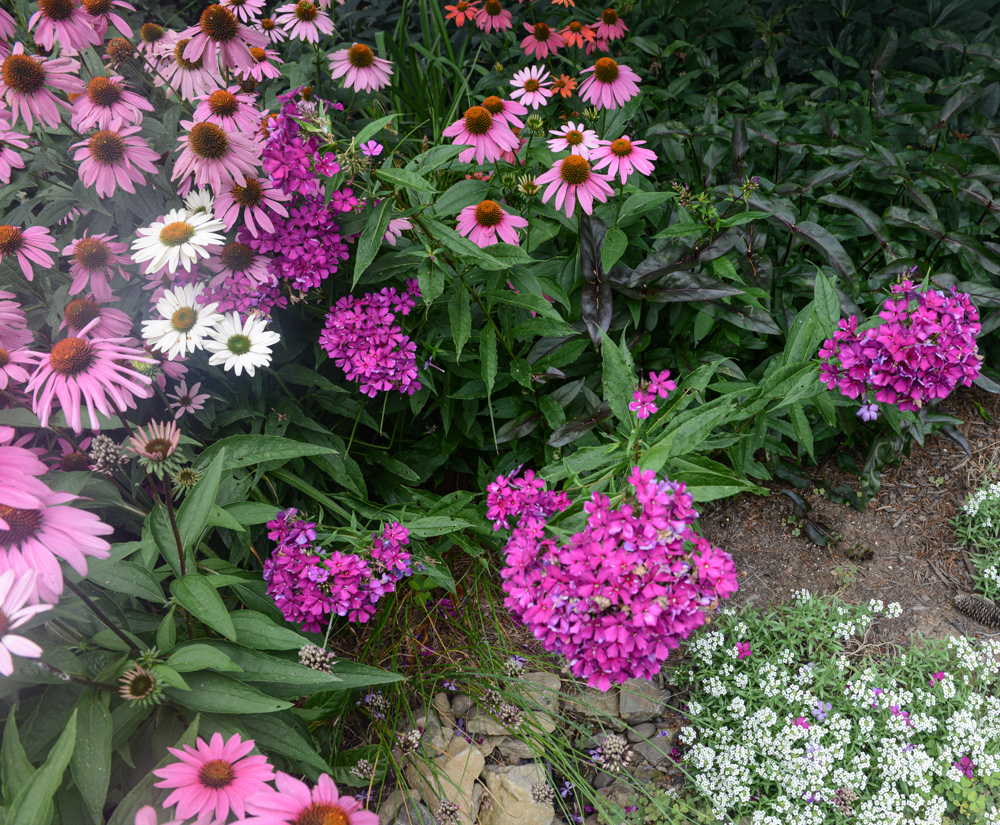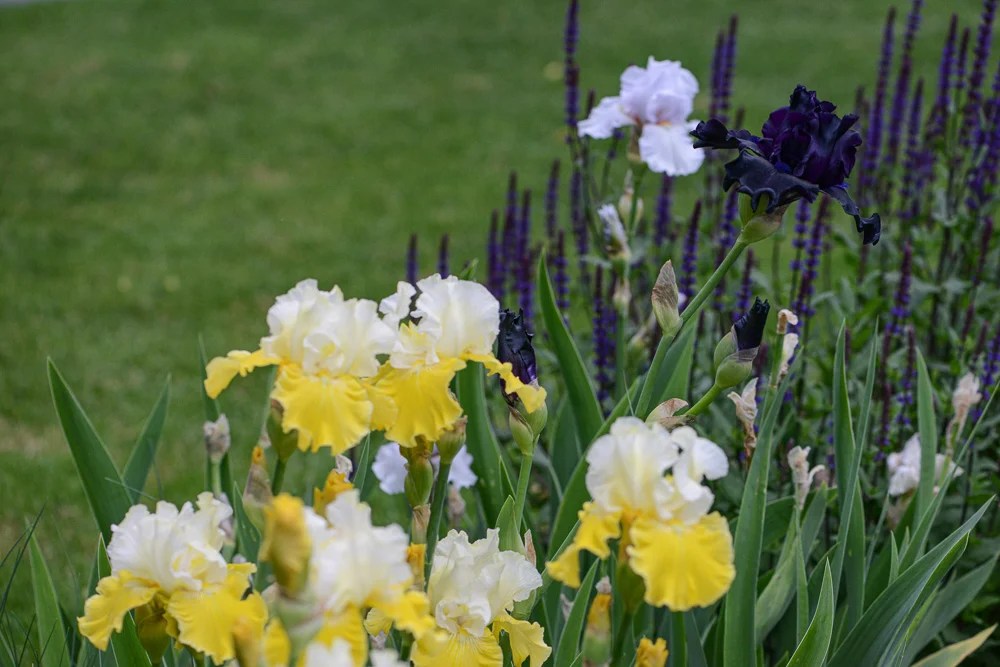This year the weather has been a mix of heat waves followed by unsually cool temps, punctuated by occasional deluges. Nevertheless, many flower species coped well. Here’s a quick virtual walk-through of my gardens. It’s mid-August as I write this, but some images are from earlier in the season.
Here is one of my front garden beds after I refreshed it three years ago. The bed finally came into its own this year. Short-toothed Mountain Mint (Pycnantheum muticum) was a particularly good addition. It’s a wonderful foil for strong colors like these echinacea. The silvery white bracts are very long-lasting, giving it a robust, fresh presence all summer. This mint is also an incredible pollinator magnet. Honeybees especially can’t get enough of it, and its menthol-like fragrance deters deer. I actually had lilies bloom unmolested in this bed for the first time in a long while, in part because the lilies were intermingled with the mint. (Nearby construction noise helped too.)
Agastache Blue Boa grew magnificently well this year, unlike past years. Various colors of echinacea, gold yarrow and red valerian keep the color coming. Not blooming yet is a two-tone blue baptisia and a pale yellow Turkish sage (Phlomis russelliana). Both plants are thriving but are still too young to bloom; next year, they should flower for the first time.



Also in this bed is a new addition that I think is a blue Marguerite (Felicia amelloides) a semi-hardy subshrub from South Africa. A specialty nursery near me carried it last year for the first time. It stays tidy and compact, covered in petite daisies non-stop from June to frost. It’s not easy to find, but if you do happen to get it, give it a light trim to keep the flushes of flowers coming all season. I’m thrilled with my three plants. They haven’t been out of bloom once the entire summer.

Also in this bed are deep fuschia phlox Nicky, navy-purple salvia Caradonna and several bearded iris (which bloomed in April and May) in shades of lemon, white and navy. Yarrow Coronation Gold and silver artemesia set off the iris and salvia nicely.



The main perennial bed next to my driveway featured soft orange double tiger lilies Flore pleno earlier in the year, lavender and white phlox, Kim’s Knee High echinacea and our native liatris, with rudbeckia and lavender Phenomenal coming on a bit later. Lambs ear Silver Queen and several catmints spill onto the blacktop. The lilies are the star of the show in July.





Pale lavender phlox Delta Snow continues to exhibit outstanding performance year over year, spreading well and staying very robust all season long despite some moderate leaf blight and mildewing this year. Native Gayfeather liatris spicata does considerably better for me than the hybrid Kobold, which is much more compact but less robust. Not visible are phlox Blue Boy and Blue Paradise. They are hanging on, but barely–– both got ravaged by mildew again this year. I no longer recommend either, sadly, as they are spectacular when healthy. A few May Night and Caradonna salvia add purple accents all summer.


At the base of the Quickfire hydrangea to the right of the gate is white variegated Sunpatiens with yellow and green foliage. A shade-loving annual, it can’t be beat for brightening up dull spots like under shrubs. The deer like it too but despite their occasional noshing I still get a lot of mileage from its bold look. This particular display is about a dozen plants.
Midsummer White phlox is medium-tall and more demure than David, bright white and long flowering, above right, center. White gaura Whirling Butterflies, cleome and Goldsturm rudbeckia round out the show.
In my other front bed, shown below, the hybrid kniphofia Bees Lemon adds punchy chartreuse and yellow color to the echinacea and liatris in July; both are nativars. Orange Rocket barberry is the deep red hedge in the background (no longer available in Pennsylvania as of 2024).
Two-toned pink coreopsis and peachy petunias hide the naked base of a rose and contrasts nicely against the grass Miscanthus Morning Light behind it. Several new, small blue and gold evergreen shrubs complete this bed. They replaced fothergilla Blue Shadow which died from too much sun. Fothergilla just cannot handle hot full sun, which it got in this spot. In partially shaded locations or full shade, it does great.
Several new pink shrub roses have been especially slow to establish so they don’t have much presence yet. Therefore the rose bed looks sparse.



On the side bank, my “wild” native prairie section is doing well, even sporting some lilies, which in past years the deer destroyed before they had a chance to bloom. This year, thanks to nearby turnpike construction, the deer stayed away far more than usual. Hence I finally got some lilies, yay!!





The real star this year is the native beebalm, which has outdone itself (tall pale lavender in the background of the photos below).
Also very attractive and robust is beebalm (monarda) Judith’s Fancy Fuschia which is a lovely cool red, not fuschia at all. This nativar selection blooms later and longer flowering than most beebalms with strong, well-formed bracts. The pollinators adore it and the cool jewel tone blends exceptionally well with many garden companions.

Always a strong performer, the double white rose of sharon Morning Star behind the coral phlox puts on its nonstop show from July to frost. This continues to be an outstanding cultivar but must be mail-ordered. I don’t know why it’s not more widely available considering its beauty and strong performance. It may be patented. (Nurseries must pay a royalty percentage to the patent holder, cutting into their profit margin.)
Now for the Not-so-good News
Leaf blights and fungal diseases are becoming more prevalent as our climate changes. With plants under stress for longer periods, root-affected rots and juglone toxicity are gaining a stronger foothold too. Some of the worst hit for me are the Fashionably Early phlox series, delphiniums, peonies, astrantia, and the less robust beebalms.
This year was especially bad for sucking infects like aphids and scale. A large scale that infects tulip poplars and magnolias suck the sap from tender branches, excreting copious “honeydew” liquid waste. This clear, sugary liquid falls like rain onto everything underneath, which in turn acts as fuel for black mold to feed on the honeydew sugars. The resulting mess under these trees is something I don’t wish on anyone. The photo below shows some of the damage, causing understory foliage to curl and die, since the mold prevents the leaves from photosynthesizing properly.



The entire understory gets coated with a layer of stubborn black gunk, from shrubs and flowerbeds to lawns and decks. Dying tree leaves fall constantly, and a thicket of twigs come down after every storm. As a result, my neighbor and I were forced to remove six 100-foot-tall poplars (by crane) from our rear properties because the scale turned our decks, roofs and rear gardens into an unsustainable nightmare.
While there is a soil drench treatment available from professional arborists, it only controls the scale. Each treatment costs upwards of $300 per tree, every year. No thank you! The trees had to come out.





The Japanese anemonies are doing well as always, although the deer insist on eating all the white ones (Honorine Jobert) I don’t know why. So I only have pink anemonies this year.
Rudbeckia hirta is lovely! It has a welcome delicacy that is missing in the hybrids. Tall yellow helenium Butterpat is just opening, while short, compact red-orange Chelsey is in full swing. Both are new this year. Chelsey unfortunately stayed quite small due to juglone toxicity. I am hoping it will do a little better after it establishes in another year or so. Right now it is less than a foot high. Midsummer white phlox rounds out the show with its dewy countenance, always very well behaved.
That’s it, folks, for now. Thank you for coming along with me. I hope your own garden is doing well and bringing you joy.

Lovely, even with the climate-related problems.
Hi Ann, thank you!
Lovely gardens, Adrienne. Thank you for sharing all of your beautiful plants and flowers.
Your photos, lovely as they are, don’t do the gardens justice. I am lucky to be able to see it from my front porch. The colors blend as nature intended. Just gorgeous!
You’re too kind, Kate! Thank you.
Just beautiful! Thank you for sharing your garden with me.
Thank you, Chris! You’re welcome.
Your garden is always an inspiration for me, and I’m so grateful for the gardening wisdom you’ve shared!
Hi Judy, your garden is inspiring to me as well!